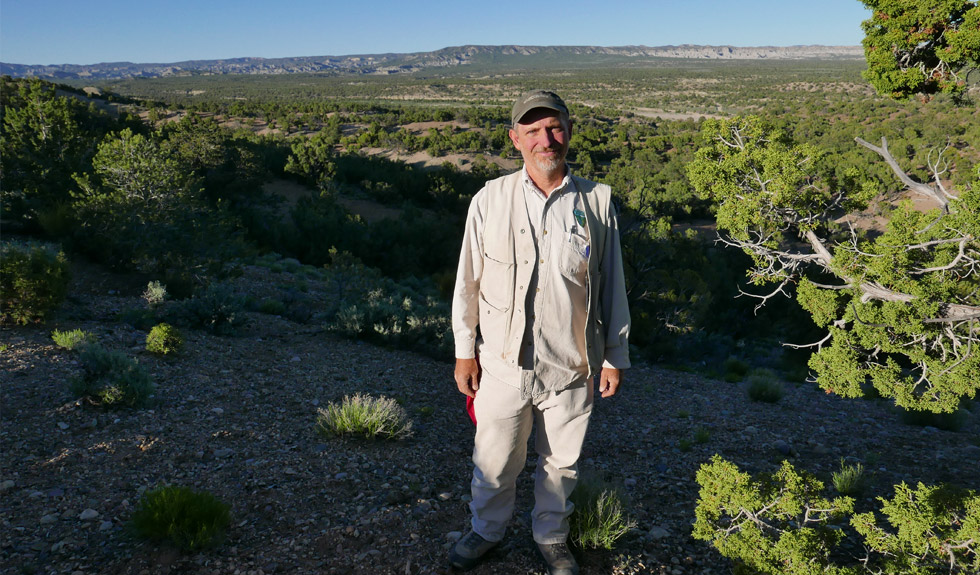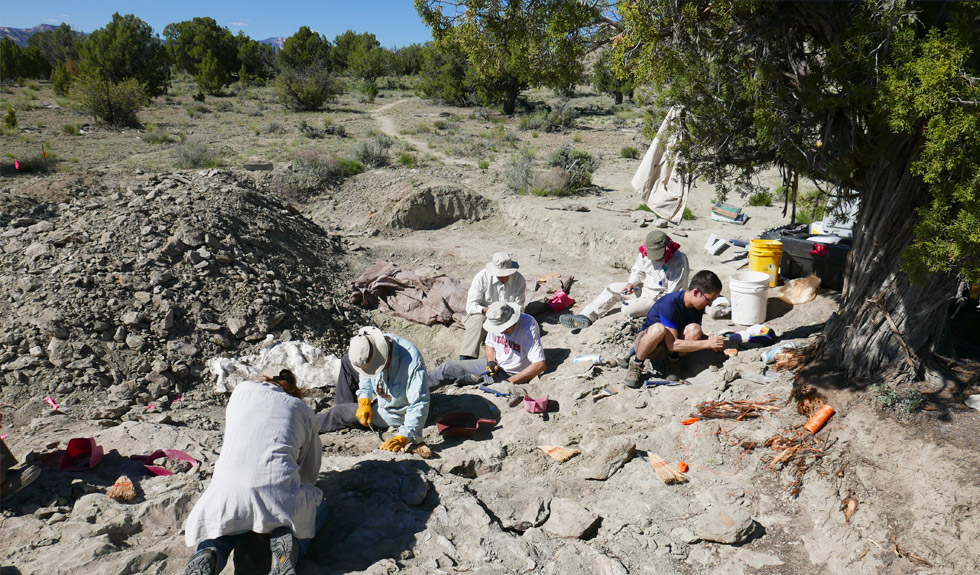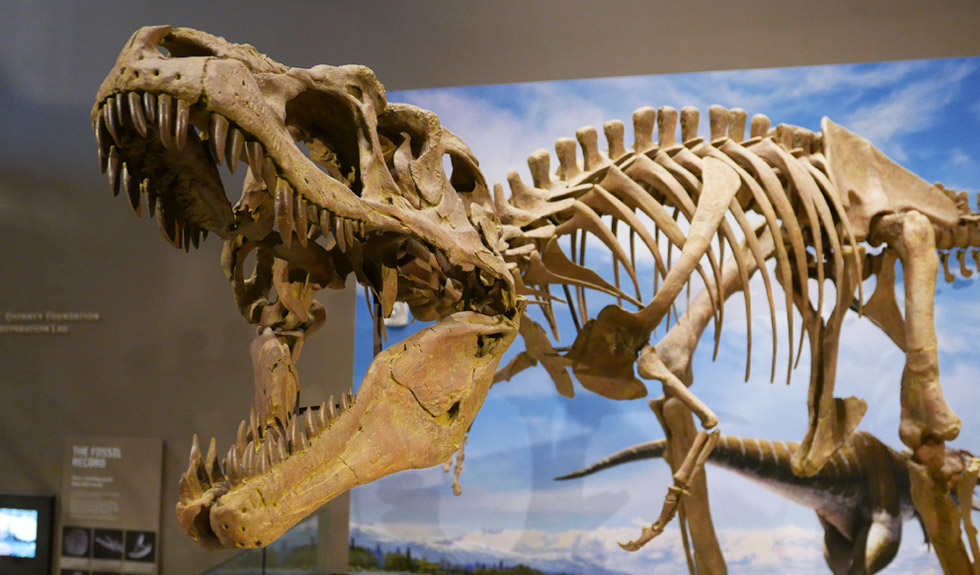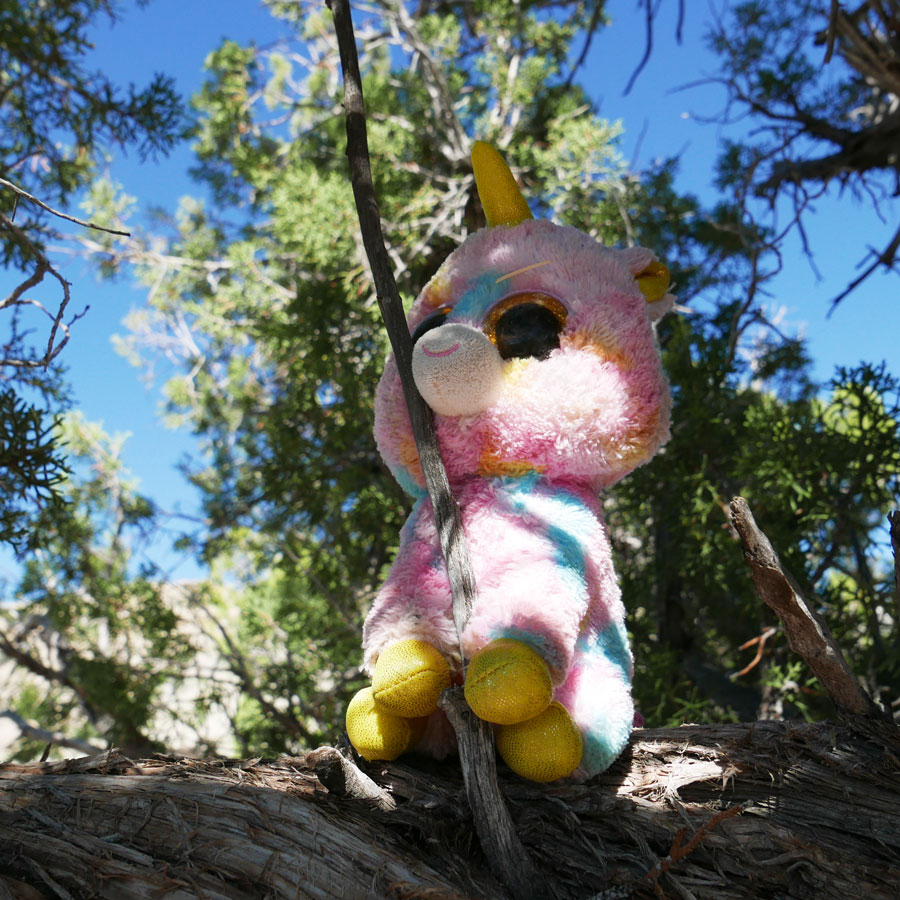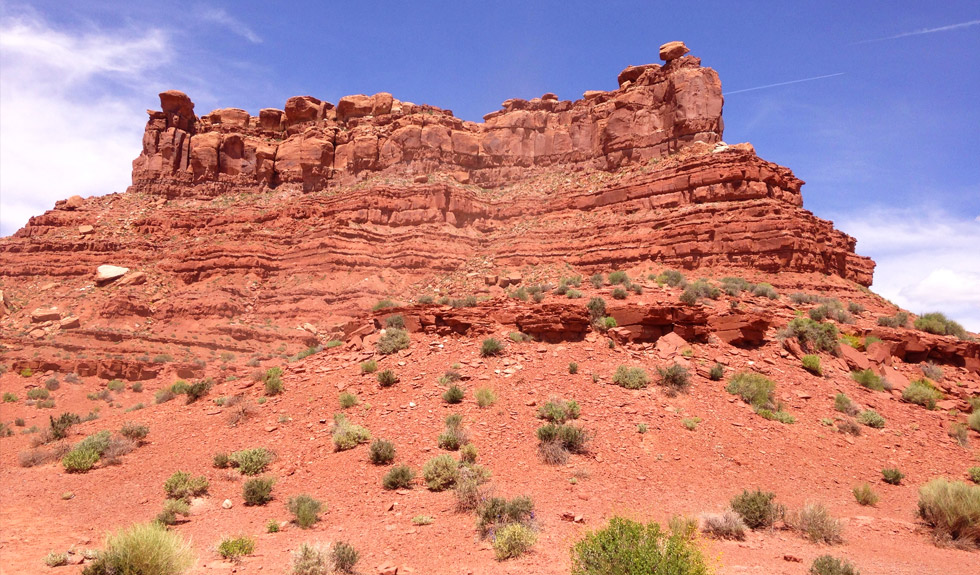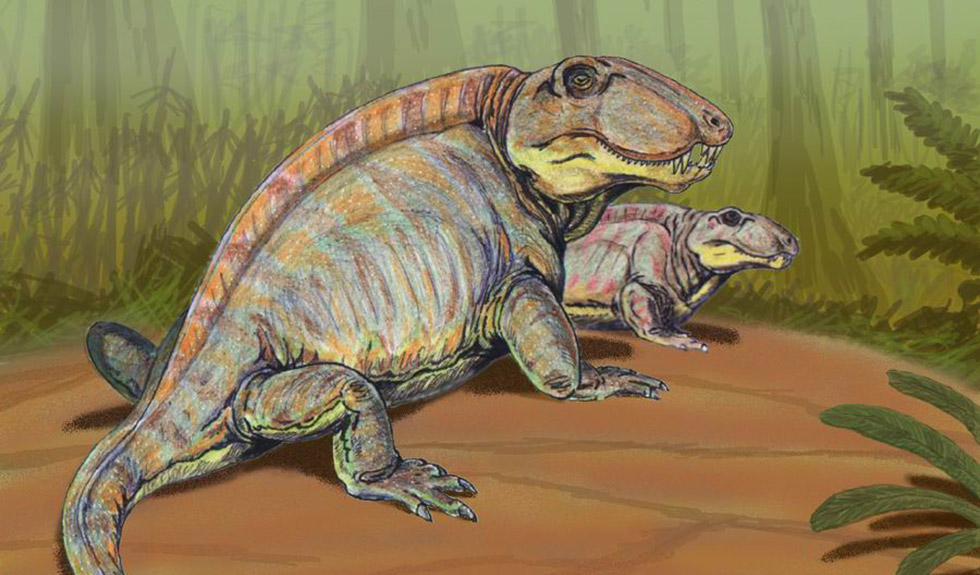Contested National Monuments in Utah House Treasure Troves of Fossils
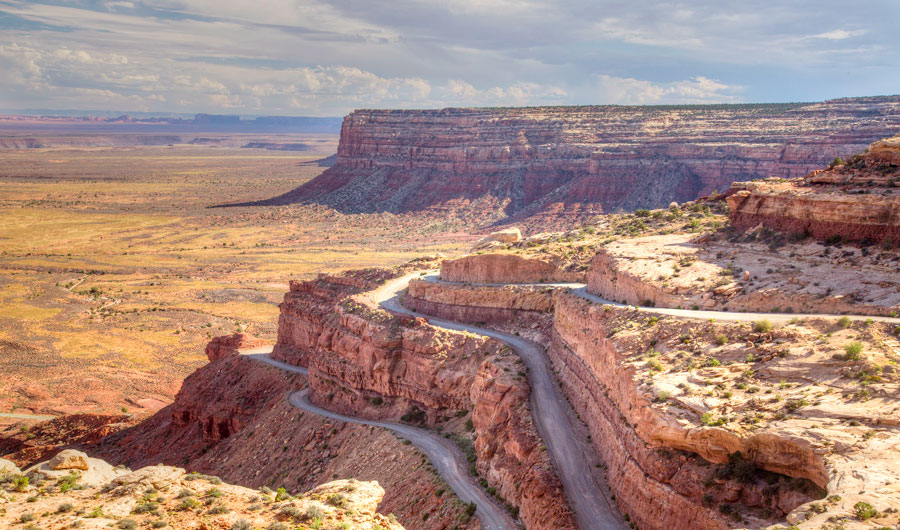
Cedar Mesa in Bears Ears National Monument
Bureau of Land Management via flickr
(Inside Science) -- Seventy-five million years ago, a family of tyrannosaurs fled through a forest engulfed in flames. The predators -- an adult more than 30 feet long, an adolescent two-thirds its size, and a baby no bigger than a Shetland pony -- emerged from the inferno onto a muddy shoreline and plunged into the lake, desperate to escape the heat.
That's what Alan Titus thinks happened here. He picks up a lump of charcoal, a burned remnant of the once-lush forest, and crumbles it between his fingers. Inches away lies an exposed tyrannosaur bone, smooth and brown.
The landscape today is a rugged plateau of pale dirt, sagebrush and scraggly junipers. It's matched by Titus' stained khaki vest and the dry smile creasing his stubbled cheeks. A paleontologist with the Bureau of Land Management, he oversees all research on dinosaurs and other fossils in Utah's Grand Staircase-Escalante National Monument.
When President Bill Clinton proclaimed the now 1.9 million-acre monument in 1996, the decision infuriated many people in Utah -- Titus included. At the time, Titus was teaching geology at Snow College, a small two-year college in the middle of the state.
"I was just as upset and shocked as anyone that this had happened, because I liked to take my students down here on field trips and collect fossils," he says. The monument designation preserved many previous land uses, such as hunting and driving all-terrain vehicles, but it banned fossil collecting without a permit, says Titus.
But Titus's perspective soon changed. The national monument designation led to new funding and resources for scientists to study fossils in Grand Staircase-Escalante, and what they found there was beyond all expectations. Rather than the familiar dinosaur species known from rocks of the same age in Canada and Wyoming, the Escalante rocks revealed a remarkable diversity of new species, upending scientists' understanding of climates and habitats during the age of dinosaurs by revealing a brand new ecosystem.
"To a scientist, it doesn’t get any better than that, because you get into this business to make discoveries and contribute new knowledge," says Titus.
Now, some paleontologists believe the same thing could happen in America's newest national monument -- at least, assuming it remains a national monument. In December, then-President Barack Obama proclaimed a 1.35 million-acre region that lies just east of Grand Staircase-Escalante as Bears Ears National Monument, reigniting outrage among some residents of Utah and their elected representatives. Now, Bears Ears lies at the center of a political debate over public lands and presidential power.
Bears Ears and Grand Staircase-Escalante are among 27 monuments currently under examination, following an executive order issued by President Donald Trump in April. The order directs Interior Secretary Ryan Zinke to review certain national monuments designated since 1996. Bears Ears is the only monument the order calls out by name, and on Monday, Zinke issued an interim report recommending that it be cut down in size.
Experts have questioned whether it would be legal for Trump to alter Bears Ears' boundaries or its national monument status. If he tries, several groups have pledged to challenge him in court, according to reporting by the Salt Lake Tribune. On June 12, when Zinke announced his recommendation to shrink Bears Ears, he also announced the extension of the public comment period for the monument until July 10.
The rocks Titus is excavating in Grand Staircase-Escalante preserve the final chapter of the age of dinosaurs. Bears Ears, researchers believe, holds different stories from earlier times -- how four-legged creatures first emerged from the sea, and how dinosaurs later rose to dominate the planet. The few paleontologists who have thus far explored in Bears Ears have made tantalizing finds, from plant-eating crocodiles to an amphibian whose skull is the size and shape of a toilet bowl lid.
But like Grand Staircase-Escalante 20 years ago, Bears Ears is in its paleontological infancy. The national monument designation, should it remain, could help researchers gain funding and support to uncover its secrets. If Bears Ears is cut in size, then funding, land use and access, and protections could change, although the exact impact on the preservation and excavation of fossils is unclear.
Rainbows and unicorns
Titus discovered the tyrannosaur site while exploring Grand Staircase-Escalante in 2014, after a rainstorm exposed a bit of buried bone.
"When I brushed it, it turned out to be the lacrimal, which is the big, scabby protrusion over the eye of an adult tyrannosaur," says Titus. "I about wet my pants."
Finding even one tyrannosaur is incredibly rare, since the Cretaceous period landscape held far fewer of the big, warm-blooded predators than it did of their plant-eating prey. But as Titus dug around the skull, he soon found the bones of at least two more individuals. This is only the third or fourth site in North America where multiple tyrannosaurs have been found together, and it provides evidence that this area's species were social, says Titus.
There are many kinds of tyrannosaurs, and these bones belong to a smaller, more ancient relative of the famous Tyrannosaurus rex. The most likely species is Teratophoneus curriei, whose name means "monstrous murderer." It is one of two tyrannosaur species discovered so far in Grand Staircase-Escalante. The remains could also represent a new species, but if they are Teratophoneus, the adult will be the first full-grown specimen ever found, says Titus.
Since the discovery of the site in 2014, Titus's team has come back for 30-40 days of each year to expand the perimeter and depth of the search, as they did in May 2017. They have found more than 1,000 bones so far, and they expect to have the whole site excavated by 2019, says Titus.
The excavation site used to be at the bottom of a lake, and Titus and his team have found thousands of fish scales amongst the tyrannosaur bones. They have also found countless lumps of charcoal, and a few pieces of fossilized mud with imprints of burned wood, the rectangular crack patterns familiar to anyone who has watched a log shrink in a campfire. For Titus, the site paints a vivid picture of a family of tyrannosaurs caught in a fire.
Now, the paleontologist and his half-dozen volunteers crouch in the desert sun, using picks and brushes to remove rock and dirt in careful layers. A stuffed toy rainbow rests in the dirt beside them, while a pink unicorn perches in a tree, overlooking the scene with huge plastic eyes. The incongruous mascots are here because of an exchange between Titus's field assistant and his former lab manager, which Titus now recounts.
"He's like, 'Hey, I hear Alan found this new tyrannosaur site. So what's it really like? 'Cause Alan, you know -- with him, everything's always rainbows and unicorns,'" says Titus. The field assistant reportedly answered, "Well, I'm afraid this time, it really is."
A surprise ecosystem
The site, now dubbed "Rainbows and Unicorns," is in a layered band of sandstone called the Kaiparowits formation, which was deposited about 75 million years ago. At that time, North America was bisected by a strip of ocean, turning the western side into a long, narrow continent called Laramidia.
Wyoming and Canada have rocks of the same age as Utah's Kaiparowits, and researchers are very familiar with the dinosaur species that are found in those northern deposits, says Titus. Everyone assumed the same species would show up in Grand Staircase-Escalante, too. But instead, practically everything Titus and his colleagues dug up was new to science.
As of now, Grand Staircase-Escalante has produced 12 named dinosaur species and five named marine reptiles, plus about 15 species that have not yet been described, says Titus. Some of his favorite finds include a duck-billed dinosaur specimen with preserved pebbly skin, and two new species of armored dinosaurs, which he describes as 12-foot-long horny toads with clubbed tails for whacking tyrannosaurs on the shins. It was probably almost impossible for tyrannosaurs to get at the horned dinosaurs, he adds; the creatures even had armored plates on their eyelids.
Titus and his colleagues think they know why the dinosaurs of Grand Staircase-Escalante are unique, although their explanation is still controversial. They believe Laramidia may have had distinct climatic zones separated by latitude, with a transition somewhere between Wyoming and southern Utah. Even though there was no physical barrier to stop dinosaurs from wandering across the transition, the species adapted to Wyoming's environment would have been unable to survive in southern Utah, and vice versa.
Northern Laramidia was probably cooler than southern Utah, with harsher weather and sparser plant life, says Titus. In contrast, southern Utah was a warm, wet coastal plain covered in lush forest, much like today's tropical rainforests.
"Just think of the Amazon," says Titus. "Loud bugs buzzing, and, you know, birds in the trees chirping. But they've all got teeth, and claws on their wings."
And like today's Amazon rainforest, Grand Staircase-Escalante may have been a biodiversity hotspot. In modern times, diversity is highest near the equator, but in the late Cretaceous, Earth's climate was much warmer. Titus speculates that in the tyrannosaurs' day, the "goldilocks zone" for vibrant, diverse life may have been right here, at around 40 degrees latitude.
"Some people think that the global average temperatures 94 million years ago were 16 degrees centigrade hotter than today. That makes the equatorial regions blisteringly hot," says Titus. "I honestly think we are sitting on peak Cretaceous tropical biodiversity here. And as you move south and north from here, it should taper off in both directions."
Titus hasn't published this idea, and before it can be tested, researchers need to excavate more fossils from around the equator, he says. But diversity does seem to be higher in the Kaiparowits than it is up north.
The Kaiparowits diversity is best illustrated by the horn-faced "ceratopsian" dinosaurs -- relatives of Triceratops whose heads are bedecked with horns and frills. For any given time slice, says Titus, the northern Laramidia habitats supported one to three known species of ceratopsian. The Kaiparowits formation in Grand Staircase-Escalante has six.
Titus thinks ceratopsians used their elaborate headgear as radiators for dissipating heat. The ornaments seem to get bigger as you go south, creating more surface area for cooling, he says. At any rate, they don't seem to be weapons, despite paleontologists' earlier assumptions, says Carolyn Levitt, paleontology collections manager at the Natural History Museum of Utah in Salt Lake City, where most of Titus's finds are stored.
"I'm telling you, if you lost one in battle and broke it off, you'd bleed to death and expose your brains," she says, gesturing at a 6-foot-long skull with horns curving outward like graceful eyebrows.
Levitt's own master's thesis research adds weight to the idea that Grand Staircase-Escalante had a gentler climate than Canada and Wyoming. Dinosaur bones from northern deposits show clear growth rings, indicating that the animals' growth slowed down each winter as they endured harsher seasonal conditions. But when Levitt examined sections of bone from horn-faced dinosaurs that lived in Grand Staircase-Escalante, she saw no rings at all -- just smooth bone suggesting abundant year-round growth.
Bears Ears' potential
While Grand Staircase-Escalante is now famous for its dinosaurs, Bears Ears is best known for its archaeological sites and deep cultural significance to several Native American tribes. Compared to Grand Staircase-Escalante, Bears Ears has seen relatively little paleontology research, so it's not clear yet just how many stories it holds about life before the dawn of humans.
But Bears Ears is rich with paleontological potential, and not just for one slice of time, according to Rob Gay, a paleontologist who is studying Bears Ears fossils and also works as education director for the Colorado Canyons Association in Grand Junction, Colorado. The new monument contains several sets of uninterrupted strata representing a staggering swath of Earth's history.
For example, the Chinle formation that Gay studies on the south side of Bears Ears predates Titus's tyrannosaurs by more than 175 million years. Back then, dinosaurs were just getting started.
"The question is: How did these puny runts that really weren't outstanding 200 million years ago become the dominant force on Earth 10 million years later?" says Gay. "To know that, we have to know what else was alive at the time."
According to Gay, the dominant lifeforms in the Chinle formation are mostly crocodiles -- or rather, precursors of modern crocodiles that had branched out into a wide range of niches and lifestyles. Some ate plants, some walked on their hind legs, and some had giant horns sprouting above their shoulders.
Other parts of Bears Ears preserve even earlier stories from the Carboniferous period, when plants overtook the land and four-legged animals called tetrapods emerged from the sea. One particularly interesting site is in Indian Creek, now a spectacular canyon of red sandstone cliffs decorated with Native American petroglyphs. Three hundred million years ago, the climate was just entering a hot, dry spell, and Indian Creek was home to a lake nestled between sand dunes.
"Not only does it tell us about what early tetrapod life was like and that there was a major sort of climate warming that was happening during that time, it also tells us something about the climate warming that's happening today," says Adam Huttenlocker, a paleontologist at the University of Southern California in Los Angeles. Huttenlocker has excavated fossils at Indian Creek in the past, and he is now collaborating with scientists from the Carnegie Museum of Natural History and California State University, San Bernardino to survey fossil sites in other parts of the monument. "We can go back, we can look at the fossil record, and we can see how animals are affected during a large-scale climate warming event."
The Bears Ears deposits from that period are especially valuable because they include both land and ocean deposits. Marine deposits are easier to date, because the small marine creatures preserved in them were similar throughout the whole ocean, says Huttenlocker. For example, he can compare marine rocks from Utah with marine rocks from Russia, and easily see which ones match in age. In Bears Ears, researchers can infer the age of land fossils with unusual precision by examining the marine deposits nearby.
That's part of why researchers know the age of one particularly bizarre object in the Natural History Museum of Utah. It was excavated in Indian Creek, and now it sits in a drawer looking like a knobbly toilet lid with droopy eye holes. Despite its flat shape, Carolyn Levitt insists the object is a whole skull, and proves her point by turning it over to reveal the brain case -- a roundish indentation smaller than one of the eye sockets. Although it hasn't yet been formally described and named, it most likely represents a new species from a genus of amphibians called Eryops, Levitt says.
Other Bears Ears rocks may reveal how life rebounded after the Permian-Triassic extinction, which wiped out an estimated 96 percent of ocean species. The monument contains a rare formation called the Moenkopi that was laid down less than 8 million years after the extinction, says Huttenlocker. No one has dug there yet to discover its secrets.
"If there's any place in North America that's going to tell us what happened after that extinction event, it would be in Bears Ears," he says. "If we can find more vertebrate sites in the Moenkopi, then we'll have a window into the recovery from the greatest mass extinction in the history of life."
A monumental impact
Paleontologists can get permits to conduct research on federal land, regardless of whether it is within a national monument. And according to Greg McDonald, regional paleontologist for the Bureau of Land Management in Salt Lake City, the Bears Ears designation has not made permits any easier or harder to obtain. But in most cases, researchers have to find their own funding for projects on regular BLM land, and such funding can be hard to come by.
National monument designations don't automatically create money for paleontology, says Scott Foss, a Washington-based paleontologist who heads the BLM paleontology program. However, the proclamations for Grand Staircase-Escalante and Bears Ears both list fossils among the exceptional resources that make the areas worthy of monument status. That puts paleontology squarely within the mandate of whoever manages the land.
For Grand Staircase-Escalante and most of Bears Ears, that's primarily still the BLM -- the same agency that managed the land before. But as national monuments, the regions are now part of the National Landscape Conservation System, a well-funded BLM directorate with real money to spend on things like paleontology, says Foss.
The access to National Landscape Conservation System funds has been revolutionary for paleontology research in Grand Staircase-Escalante, says Gay. After the monument was proclaimed, the BLM built a new fossil prep lab there and hired a full-time lab manager. They also hired Alan Titus as the monument paleontologist, and he is now one of just eight full-time BLM paleontologists in the entire country, says Foss.
Monument designations also draw attention to a region and make it more competitive for funding from other sources, such as grants from the National Science Foundation and private nonprofit organizations, according to Utah State Paleontologist Jim Kirkland in Salt Lake City.
"There was virtually nothing known with Grand Staircase until it was proclaimed," says Kirkland. "And Grand Staircase has now turned out to have the most complete terrestrial upper Cretaceous record on the planet."
Now, Bears Ears is in a position similar to that of Grand Staircase-Escalante two decades ago, except that many decisions about research funding are on hold because of the political situation, including the executive order to review National Monuments, says Foss. There's no word yet on whether Bears Ears will get its own paleontologist.
However, the Trump administration's 2018 budget proposal asks for a roughly 25 percent cut in overall funds for the National Landscape Conservation System budget, and a focus on public safety, law enforcement and sportsmen's access, although the amount for paleontology is not specified.
"There's such a huge, enormous amount of uncertainty, not just in Bears Ears but all across our programs right now," says Foss. "We are just waiting to find out what's going to happen next."
Back at camp after a day of digging, Titus and his volunteers turn their attention to food and beer. The toilet, says Titus, is generally agreed to be over that way -- away from the bedrock and any future excavations by prospecting paleontologists. As the sun lowers, he stands on the edge of the plateau and looks over the landscape where he uncovered an ancient ecosystem.
There, he says, is where his team discovered the horned dinosaur species with the elaborate folded neck frill. That sandstone ridge is where they found the one that was named after him, and behind those scraggly trees is where they found the mummified hadrosaur. The club-tailed ankylosaurs came from the spot next to it, and that sagebrush-covered plain in the middle held the pachycephalosaur with its crown of spongy bone.
Titus says he sees the desert vista as the dinosaurs would have, lush and tropical.
"I hear their shrieks and cries on the wind."

